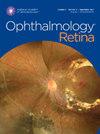Endophthalmitis after Pars Plana Vitrectomy
IF 5.7
Q1 OPHTHALMOLOGY
引用次数: 0
Abstract
Objective
Endophthalmitis is a rare but devastating complication of pars plana vitrectomy (PPV). We assessed the incidence, profile, and prognostic factors of post-PPV exogenous endophthalmitis in a large ethnically diverse cohort over an 11-year period.
Design
A retrospective single-site cohort study.
Participants
Adult patients (aged ≥18 years) undergoing PPV at Moorfields Eye Hospital.
Methods
Pars plana vitrectomy procedures between January 1, 2013 and January 1, 2024 were extracted from the electronic health record and cross-referenced with all endophthalmitis cases using clinical documentation, prescription records, and incident reports.
Main Outcome Measures
The incidence proportion was estimated and stratified by additional procedures during PPV. Odds ratios (ORs) with 95% confidence intervals (CIs) for the association between endophthalmitis and exposures were estimated using univariable and multivariable logistic regression models.
Results
There were 36 179 procedures from 26 533 patients included in the analysis. The overall incidence of post-PPV endophthalmitis was 0.05% (n = 19), of which 63.2% (n = 12) were culture positive. Five cases occurred after 28 days, of which 3 had coexisting anterior segment pathology including corneal abscesses and loose sutures. Incidence figures varied from 0.05% in PPV with internal limiting membrane peel to 0.65% in those undergoing intraocular lens (IOL) exchange. Higher odds of endophthalmitis were seen with fluid tamponade (adjusted OR [aOR], 5.70; 95% CI, 1.80–18.03; P = 0.003) and increasingly complex secondary IOL procedures—secondary IOL insertion alone (aOR, 5.42; 95% CI, 1.23–23.97; P = 0.026); IOL removal (aOR, 9.81; 95% CI, 3.10–31.07; P = 1.0 × 10−4); and IOL exchange (aOR, 13.64; 95% CI, 4.29–43.43; P = 9.7 × 10−6). When adjusting for tamponade, IOL removal (aOR, 4.64; 95% CI, 1.14–18.86; P = 0.032) and IOL exchange (aOR, 6.24; 95% CI, 1.43–27.27; P = 0.015) remained significantly associated with endophthalmitis. Endophthalmitis associated with secondary IOL procedures were all culture positive (n = 3 Staphylococcus spp, n = 3 Streptococcus spp).
Conclusions
Although post-PPV exogenous endophthalmitis is rare, individuals undergoing PPV with IOL removal and exchange have considerably increased odds of developing endophthalmitis. Delayed cases of endophthalmitis frequently have coexisting anterior segment pathology.
Financial Disclosure(s)
Proprietary or commercial disclosures may be found in the Footnotes and Disclosures at the end of this article.
玻璃体切割术后眼内炎:英国伦敦一项为期11年的36,179例手术回顾性队列研究。
目的:眼内炎是睫状体部玻璃体切除术(PPV)中一种罕见但具有破坏性的并发症。我们评估了ppv后外源性眼内炎的发生率和概况,并在11年的时间里调查了一个大型种族多样化队列的因果关系和预后因素。设计:回顾性单点队列研究。参与者:在Moorfields眼科医院接受PPV的成年患者(18岁及以上)。方法:从电子健康记录中提取2013年1月1日至2024年1月1日的PPV手术,并与所有眼内炎病例的临床文献、处方记录和事件报告进行交叉对照。主要结局指标:通过PPV期间的附加手术对发生率进行估计和分层。使用单变量和多变量logistic回归模型估计眼内炎发病率与社会人口学和程序因素之间的比值比(OR)和95%置信区间(CI)。结果:来自26,533例患者的36,179例手术纳入分析。ppv术后眼内炎总发生率为0.05% (n=19),其中培养阳性63.2% (n=12)。28 d后发生5例,其中3例合并角膜前段病变,包括角膜脓肿和缝合线松动。发生率从有内限制性膜剥离的PPV的0.05%到人工晶状体(IOL)置换的0.65%不等。眼内炎的发生率较高的是液体填塞(调整后的比值比[aOR] 5.70, 95% CI: 1.80, 18.03, p= 0.003)和越来越复杂的二次人工晶状体手术——单独放置二次人工晶状体(aOR 5.42, 95% CI: 1.23, 23.97, p=0.026);人工晶状体摘除(aOR 9.81, 95% CI: 3.10, 31.07, p=1.0 × 10-4);人工晶状体置换术(aOR 13.64, 95% CI: 4.29, 43.43, p=9.7 x 10-6)。当进行压塞调整时,人工晶状体取出(aOR: 4.64, 95% CI: 1.14, 18.86, p= 0.032)和人工晶状体置换(aOR: 6.24, 95% CI: 1.43, 27.27, p=0.015)仍与眼内炎显著相关。继发性人工晶状体手术相关的眼内炎均为培养阳性(葡萄球菌3例,链球菌3例)。结论:虽然PPV术后外源性眼内炎很少见,但接受PPV并摘除和置换人工晶状体的个体发生眼内炎的几率显著增加。迟发性眼内炎常伴有前节病变。
本文章由计算机程序翻译,如有差异,请以英文原文为准。
求助全文
约1分钟内获得全文
求助全文

 求助内容:
求助内容: 应助结果提醒方式:
应助结果提醒方式:


